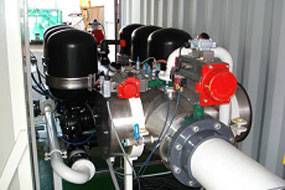Emergency Ballast Water Treatment Operation
Fairhaven Shipyards in Bellingham, Washington purchased a barge, Lucky Angel, with the intent of towing it from China to the U.S., refurbishing it and using it as a submersible dry-dock. The 435 ft long by 132 ft wide barge, renamed Faithful Servant, was loaded with an estimated 11,500 m3 – 19,000 m3 of ballast water from unknown Chinese coastal waters. The shipyard faced a dilemma: conduct an open-sea exchange, easy but risky, or bring the barge into Washington state waters and proactively address aquatic invasive species prior to de-ballasting. They chose the latter.
Jeff Sokolik, Fairhaven’s Port Engineer, had a big job ahead of him. Not only did he have to unload water safely but he also had to unload the heavy, thick sediments that had accumulated over the years from the Chinese waters. The objective was to remove every bit of sediment so that future de-ballasting would not cause contamination. This was not an ordinary task.
Fairhaven contacted the U.S. Coast Guard who referred them to the State of Washington, Department of Fish and Wildlife. The answer was the Hyde Guardian, a system previously approved by the department for use by two cruise ships in state waters. The Guardian uses no chemicals and has a filtration system, which would effectively facilitate removal of all sediment, and a UV treatment system that would prevent discharge of viable foreign organisms into the local waters. The system’s manufacturer, Hyde Marine, Inc., recognized the environmental importance of the situation and offered Fairhaven Shipyard courtesy use of the Hyde Guardian. The proposed solution was Hyde’s skid-mounted, stand-alone unit, the actual equipment used to successfully pass the IMO (G8) land-based testing at the NIOZ (Netherlands Institute for Sea Research) ballast water test facility in The Netherlands.
Hyde dispatched its 20 ft Guardian container, equipped with the Hyde Guardian Model HG 300, to the site. In addition, Hyde Commissioning Engineer, Christian Terrientes, traveled to the site to operate the unit in cooperation with shipyard personnel.
Treatment began during the week of January 13, 2009 and took approximately two weeks to complete due to the external application and other complexities of the situation. In normal circumstances, a treatment system would have been installed as an integral part of the barge, allowing for processing of ballast water as it was taken on and discharged.
Terrientes stated that the conditions the Hyde Guardian system encountered onboard the Faithful Servant during those two weeks were tough and were comparable to water conditions existing in the Yangtze River in China. The barge’s ballast tanks were full of mud and sediment that had been accumulating during years of operation in muddy Chinese waters. In addition, because the container and treatment system were placed dockside, the Hyde Guardian unit was subject to freezing temperatures (-5°C) as well as snow and rain. The Hyde Guardian system was operated 12 hours per day and at times round-the-clock to maintain the schedule. During the project, the Hyde Guardian performed more than 450 backwash cycles. The only technical challenge encountered was a malfunctioning pressure differential switch which froze due to the low ambient temperatures.
After offloading was complete, the Guardian was used to dewater the filter backflush slurry, before it was delivered to a licensed waste processor, and to treat local water used to flush out the remaining tank sediment.














